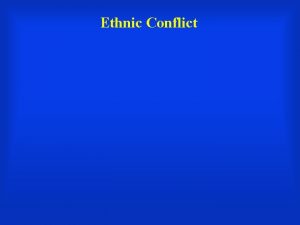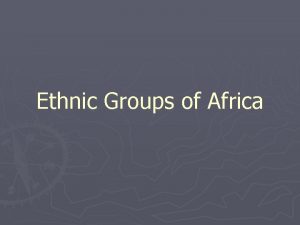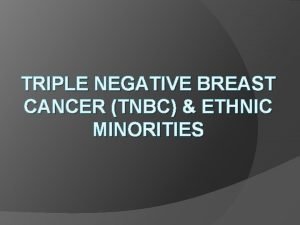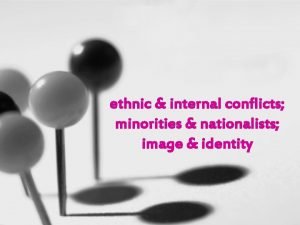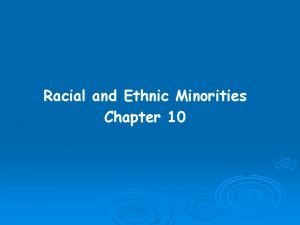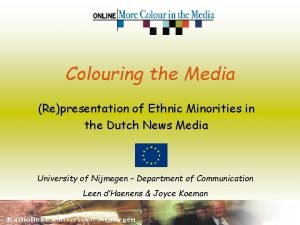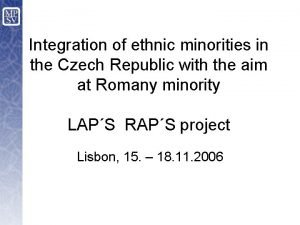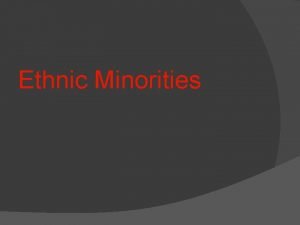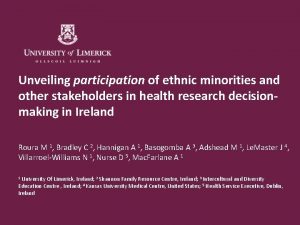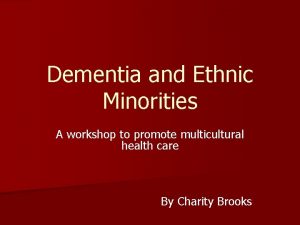Ethnic minorities in the workplace Omar Khan Director













![Subject with highest BME representation [1] Subject BME share Law Medicine and dentistry Business, Subject with highest BME representation [1] Subject BME share Law Medicine and dentistry Business,](https://slidetodoc.com/presentation_image_h2/8c2f32860a24142357aed39e03fad611/image-14.jpg)




- Slides: 18

Ethnic minorities in the workplace Omar Khan, Director 1

About Runnymede is the UK’s leading independent race equality think tank. We work through: §High quality research and analysis §Engaging communities §Influencing policy 2

Summary of presentation • General data on ethnic minorities • Data related to professionals • Why, and how to respond 3

Growth of BME population, 1971 -2051 30 27, 0 25 20, 7 20 15 13, 9 10 5, 5 5 2, 4 0 1971 1991 2011 2031 2051 4

BME population by age, 2016 Age group UK BME London BME proportion Under 13 ca. 24% Ca. 55% 13 -19 19% 53% 20 -29 18% 48% 30 -44 19% 40% 45 -54 13% 39% 55 -64 9% 34% 65 -74 5% 24% 75+ 4% 21% 5

Child poverty by ethnic group

Low pay and wage inequality

Much wage inequality driven by ‘occupational segregation’

But also over-qualification (see also Runnymede briefing on Russell group graduates)

GCSE Attainment 1991 -2006 80 70 60 50 40 30 20 10 0 1991 1993 1995 White 1997 Black Indian 1999 Pakistani 2001 2003 2006 Bangladeshi 10

GCSE Attainment 2015 Chinese Indian White Irish Bangladeshi White British Mixed Black African Other White Pakistani Other Asian Other Black Caribbean Traveller of Irish heritage Gypsy / Roma 0, 0 10, 0 20, 0 30, 0 Girls 40, 0 Boys 50, 0 60, 0 70, 0 80, 0 90, 0 11

University Participation 80 70 60 50 40 1993 30 2003 2013 20 10 0 1993 2003 2013 White Black Mixed Indian 25 35 39 34 52 61 35 44 50 42 57 57 Pakistani/Ba Chinese/Oth ngladeshi er 31 54 45 62 54 67 All 26 37 42 12

Degree Attainment by ethnic group, 2012 Ethnic Group First 2: 1 2: 2 White 19. 1 53. 0 23. 5 Third/ Pass 4. 4 All BME 10. 7 42. 9 36. 2 10. 2 Black 6. 2 36. 9 43. 1 13. 8 Asian 11. 5 43. 6 35. 5 9. 4 Chinese 15. 2 47. 5 28. 8 8. 4 Mixed 15. 0 50. 3 28. 5 6. 3 Other 12. 0 45. 4 32. 9 9. 7 13
![Subject with highest BME representation 1 Subject BME share Law Medicine and dentistry Business Subject with highest BME representation [1] Subject BME share Law Medicine and dentistry Business,](https://slidetodoc.com/presentation_image_h2/8c2f32860a24142357aed39e03fad611/image-14.jpg)
Subject with highest BME representation [1] Subject BME share Law Medicine and dentistry Business, administrative studies Computer science Subjects allied to medicine Engineering and technology Social studies Mathematical sciences Total for all subject areas 32. 1 31. 6 30. 2 28. 5 24. 5 22. 8 22. 3 19. 9 From ECU (2013), p. 72. The least popular subject areas among BME students were agriculture and related subjects (4. 3%), veterinary science (4. 7%) and historical and philosophical studies (8. 9%). [1] 14

Occupational data Ethnic Group All categories: Ethnic group White: Total 1. Managers, directors and senior officials 4. 6. Caring, 7. Sales 3. Associate 8. Process, Administrati 5. Skilled leisure and 2. 9. professional plant and ve and other customer Professional trades Elementary and technical machine occupations secretarial occupations service occupations operatives occupations 10. 8% 17. 4% 12. 7% 11. 4% 11. 5% 9. 4% 8. 4% 7. 2% 11. 0% 16. 8% 12. 8% 11. 7% 12. 1% 9. 3% 8. 1% 7. 2% 11. 0% 11. 1% 16. 6% 12. 9% 12. 0% 12. 2% 9. 4% 8. 4% 7. 1% 10. 4% 12. 8% 27. 6% 13. 4% 10. 4% 9. 5% 7. 7% 4. 8% 5. 4% 8. 4% 9. 5% 18. 5% 11. 9% 7. 6% 11. 0% 7. 8% 5. 1% 9. 1% 19. 4% 8. 6% 18. 0% 15. 6% 10. 6% 8. 3% 10. 1% 10. 8% 5. 2% 12. 7% 10. 7% 22. 5% 10. 1% 9. 6% 7. 4% 7. 7% 11. 8% 8. 4% 11. 8% 6. 1% 20. 7% 11. 7% 10. 7% 6. 4% 15. 1% 9. 2% 5. 9% 14. 2% 11. 2% 21. 7% 11. 7% 7. 9% 9. 6% 8. 0% 8. 7% 7. 4% 13. 8% English/Welsh/Scottish/ Northern Irish/British Irish Other White Mixed/multiple ethnic group Asian/Asian British Black/African/Caribbea n/Black British Other ethnic group 15

BME representation • Law Society stats: BME individuals 3% of solicitors on the Roll and 16% of barristers (compare to 14% population; 44% on professional training course) • Around 5% of judges; 4% of QCs • 3. 5% of directors in TV • 1 in 16 top management positions • 58 FTSE 150 directors (3. 9%) are BME • 8% London NHS Trust board members are BME • BME people on UK (and US) corporate boards is declining 16

Why? And How respond? • Persistent disadvantage: poverty, lab market, education • Demography • Unconscious bias • Recruit similar rather than diverse • Targets 17

Thank you! • Contact me: omar@runnymedetrust. or g 18
 Samia yusuf omar hodan yusuf omar
Samia yusuf omar hodan yusuf omar Một số thể thơ truyền thống
Một số thể thơ truyền thống Sơ đồ cơ thể người
Sơ đồ cơ thể người Công thức tính thế năng
Công thức tính thế năng Các số nguyên tố là gì
Các số nguyên tố là gì Tỉ lệ cơ thể trẻ em
Tỉ lệ cơ thể trẻ em đặc điểm cơ thể của người tối cổ
đặc điểm cơ thể của người tối cổ Các châu lục và đại dương trên thế giới
Các châu lục và đại dương trên thế giới ưu thế lai là gì
ưu thế lai là gì Thẻ vin
Thẻ vin Các môn thể thao bắt đầu bằng từ đua
Các môn thể thao bắt đầu bằng từ đua Tư thế ngồi viết
Tư thế ngồi viết Cái miệng xinh xinh thế chỉ nói điều hay thôi
Cái miệng xinh xinh thế chỉ nói điều hay thôi Hát kết hợp bộ gõ cơ thể
Hát kết hợp bộ gõ cơ thể Từ ngữ thể hiện lòng nhân hậu
Từ ngữ thể hiện lòng nhân hậu Trời xanh đây là của chúng ta thể thơ
Trời xanh đây là của chúng ta thể thơ Tư thế ngồi viết
Tư thế ngồi viết Chó sói
Chó sói Thế nào là giọng cùng tên
Thế nào là giọng cùng tên



















